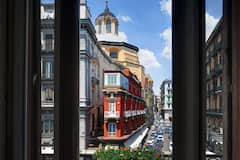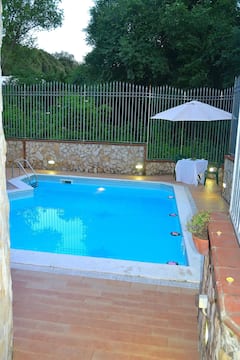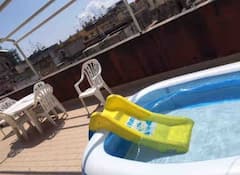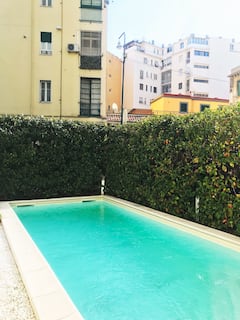It’s a beautiful day, sunny and warm. You step along the same stone-paved lanes that bustled with people and carts and animals about 2,000 years ago. Shops and taverns line the streets, as if they’re still waiting for customers. Paint and tilework are here and there still intact, giving hints of how this city looked in its heyday. You turn the corner, and there, above, in the distance, looms the summit of Vesuvius, the mountain responsible for engulfing Pompeii in a near instant. Exploring the ruins, one can’t ever quite forget the city’s tragic end, yet so much detail is preserved that it’s easy to envision the buildings in good repair, and full of people. In a way, you can still meet some of these people, who still haunt the space
A living landscape in the shadow of Death

It’s an odd juxtaposition: the city, once buried by ash, lying at the foot of its indifferent destroyer. Adding to this sense of tension is the modern urbanity that sprawls across the region. Lovely Italian homes, businesses, and churches sit calmly downhill of Europe’s most dangerous active volcano. One can stand amid the ruins of ancient Pompeii and look out over the contemporary city and almost feel a cosmic time-clock ticking away. Hopefully, there are better methods now of monitoring the mountain’s moods. Yet seeing nature’s power overshadowing the past and the present in this way offers a rare perspective, a sort of cosmic view on man’s relationship with the environment.
Stop in for a drink, the shops are - almost - open

Okay, so the taverns aren’t exactly still serving drinks. And the mill isn’t cranking out flours. But as you work your way through the city, these shops are still standing, sans rooves. Most of the portable accoutrements have been taken to museums, but the built-in features remain, and almost look like they’re in working order.
If your touring makes you hungry, and you’d like a working eatery, there are cafes clustered around the archaeological site’s main entrances. Flavored ices are especially nice after an afternoon in the sun.
Tile mosaics you’ll want in your own home

Perhaps the best-preserved feature in Pompeii are the mosaic floors, especially in the larger homes. The detail is exquisite, putting to shame any factory-made options available today at home improvement stores. Every design is different, made specifically for the space, sometimes an entry hall, sometimes surrounding a bath. Watch for images of sleeping or chained dogs incorporated into thresholds. This was a way of declaring, “cave canem” (beware of dog).
While many of the more striking images have been excavated and taken to museums, like the Alexander Mosaic from the House of the Faun, there are still many examples left in situ, and still appearing new enough to be serviceable. You won’t be able to resist tracing your fingers over the work made so long ago by artisans’ hands.
You might be interested in these Airbnbs!
Delightful ancient murals still have full-color details

The surviving frescoes are more delicate than the stone mosaics, yet centuries underground have kept the paint pigments vibrant enough to really get a sense of the splendor and detail. Many of the stucco walls throughout the city have been lost, but in the large homes, vast sections, even entire rooms, remain.
Some of the more entertaining murals can be found in the brothels (both public and within private homes). Images in these places might remind one of flipping through a manual on sexual positions; they depict a variety of sexual options. The graphic images would seem to work as well for a pictorial menu of services as for wall art. Parents wishing to shield their children from the ways of the world need not worry, the brothels are clearly marked on the map, and on-site by the entrance.
A haunting reminder

The Forum Granary (Granai del Foro), situated between the temples of Apollo and Jove, has been repurposed to house troves of artifacts dug up during the excavation. The stores are gated, and shielded with plexi-glass, but fully visible to visitors. The most notable pieces in the collection are the seemingly countless amphorae (storage pots) and the plaster casts, made by excavators, from the depressions left behind when people were incinerated in the volcanic flows.
When you walk the streets, there are no bodies, no bits of kitchen-mongery left hastily aside. All of that’s been cataloged and cleared away. But under the granary roof, the evidence of countless interrupted lives lies heaped and stacked, a warehouse of Pompeii’s last day. Human remains are the real focus here. Several casts are set out so that visitors can see individual victims, huddled or lying, often covering their mouths against the grit swirling around them before they were buried and burned.
When tourists approach this spectacle, most become more hushed, reflective. It’s impossible not feel a mild funereal weight. Laying eyes on the relics of a person in the very moment of death is a powerful experience, like spying on a stranger in a most intimate moment, like looking through a wormhole in time. You might even find yourself clearing your throat, responding reflexively to the sensation of ash in your lungs.
A worthy destination
Pompeii is a treasure of archeology and history. And you can experience it directly; very little of it is roped or walled off. You can climb all over it, and walk around through it. You can interact with a preserved piece of the ancient world. The sense of immersion in this first century space is thorough enough, you may find that getting back out for dinner, or stepping back onto the train, feels as though you’ve tripped somehow through time.
History
Get Trip101 in your inbox
Unsubscribe in one click. See our Privacy Policy for more information on how we use your data




















Create an account to